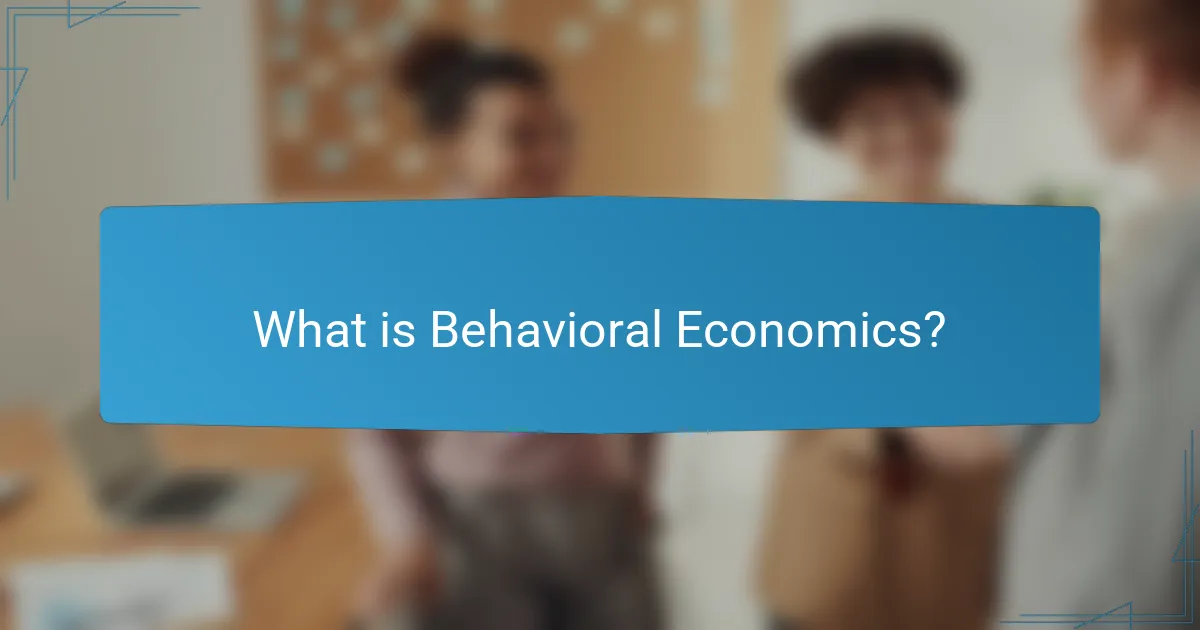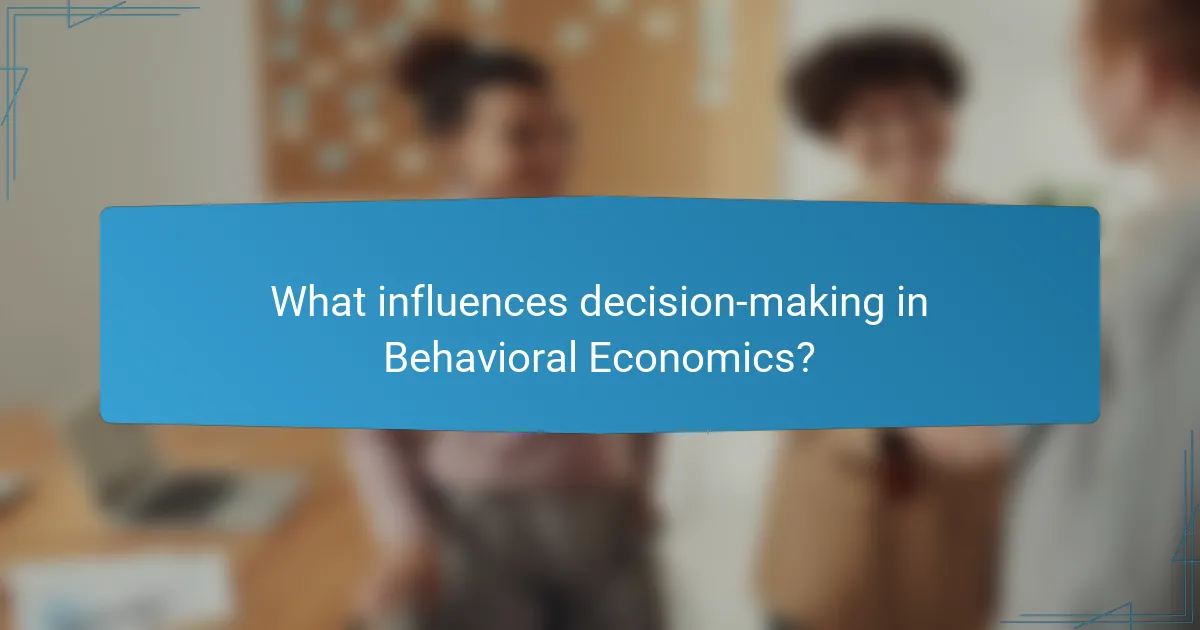Behavioral economics is a field that merges psychology and economics to understand how psychological factors impact economic decision-making. It challenges traditional economic theories by demonstrating that emotions and cognitive biases, such as loss aversion, significantly influence choices, often leading to irrational behaviors. Key concepts include the impact of social factors and emotional responses on decision-making, as well as practical applications like default options in retirement plans and the framing effect in marketing. This article explores the insights of behavioral economics, its influence on decision-making processes, and provides real-world examples that illustrate its significance in understanding consumer behavior and market dynamics.

What is Behavioral Economics?
Behavioral economics is a field that combines insights from psychology and economics. It studies how psychological factors influence economic decision-making. Traditional economics assumes people are rational and make decisions based on utility maximization. However, behavioral economics shows that emotions and cognitive biases often lead to irrational choices. For instance, people may exhibit loss aversion, preferring to avoid losses over acquiring equivalent gains. Research by Kahneman and Tversky highlighted these biases, demonstrating their impact on financial decisions. This field helps explain phenomena like market anomalies and consumer behavior.
How does Behavioral Economics differ from traditional economics?
Behavioral economics differs from traditional economics by incorporating psychological insights into economic decision-making. Traditional economics assumes that individuals are fully rational and make decisions solely based on available information. In contrast, behavioral economics recognizes that people often act irrationally due to cognitive biases and emotional influences. For instance, traditional models often overlook how framing effects can alter choices. Behavioral economics studies these deviations from rationality, highlighting phenomena like loss aversion and overconfidence. Research such as “Nudge” by Richard Thaler and Cass Sunstein illustrates how small changes in presentation can significantly impact decisions. Thus, behavioral economics provides a more nuanced understanding of human behavior in economic contexts.
What are the key principles of Behavioral Economics?
The key principles of Behavioral Economics include bounded rationality, loss aversion, and social preferences. Bounded rationality suggests that individuals make decisions based on limited information and cognitive limitations. Loss aversion indicates that losses weigh heavier on individuals than equivalent gains. Social preferences highlight that people care about fairness and the welfare of others, influencing their economic decisions. These principles challenge traditional economic theories that assume rational decision-making. Research like Kahneman and Tversky’s prospect theory supports these principles by demonstrating how people evaluate potential losses and gains.
How do cognitive biases influence economic decisions?
Cognitive biases significantly influence economic decisions by distorting perception and judgment. These biases lead individuals to make irrational choices based on emotions rather than objective analysis. For example, the anchoring bias causes people to rely heavily on the first piece of information they encounter. This can skew their evaluation of prices or value. Another example is loss aversion, where individuals prefer avoiding losses over acquiring equivalent gains. Research shows that people are more likely to take risks to avoid losses than to achieve gains. These biases can result in suboptimal financial decisions, such as overpaying for investments or avoiding beneficial risks. Studies in behavioral economics demonstrate that understanding these biases can help improve decision-making processes.
What are the main insights derived from Behavioral Economics?
Behavioral economics reveals that individuals often make irrational decisions influenced by cognitive biases. These biases include loss aversion, where losses weigh heavier than gains. Anchoring occurs when initial information disproportionately affects subsequent judgments. Additionally, mental accounting shows how people categorize money differently, impacting spending behavior. The endowment effect indicates that ownership increases perceived value. Social norms can significantly influence decision-making, as seen in public goods contributions. Finally, framing effects demonstrate how the presentation of choices can alter preferences. These insights help explain real-world economic behavior beyond traditional rational models.
How do social norms impact decision-making?
Social norms significantly influence decision-making by shaping individual behaviors and attitudes. These unwritten rules guide what is considered acceptable or desirable in a given society. Individuals often conform to social norms to gain acceptance or avoid social disapproval. Research indicates that people are more likely to engage in behaviors that align with the expectations of their peers. For instance, a study published in the Journal of Personality and Social Psychology found that individuals are influenced by the behaviors of others in situations involving public goods. The findings suggest that social norms can enhance cooperation in group settings. Overall, social norms serve as a powerful framework that affects choices in various contexts, including economic decisions.
What role does heuristics play in economic choices?
Heuristics play a significant role in economic choices by simplifying decision-making processes. These mental shortcuts help individuals make quick judgments without extensive information. For example, people often rely on the availability heuristic, where they assess the likelihood of events based on recent experiences. This can lead to biases, such as overestimating risks of rare events. Research by Tversky and Kahneman highlights how heuristics influence economic behavior, showing that individuals often deviate from rational decision-making. Their work demonstrates that heuristics can lead to systematic errors in judgment, impacting choices in financial markets and consumer behavior.

What influences decision-making in Behavioral Economics?
Decision-making in Behavioral Economics is influenced by cognitive biases, social factors, and emotional responses. Cognitive biases, such as loss aversion, affect how individuals perceive risks and rewards. Social factors, like peer influence and cultural norms, shape choices and preferences. Emotional responses, including fear and excitement, can lead to irrational decisions. Research shows that these influences often lead to deviations from traditional economic models. For instance, the concept of ‘nudge’ illustrates how small changes in context can significantly alter decision outcomes. Behavioral Economics emphasizes that human behavior is not always rational, challenging classical economic theories.
How do emotions affect economic decisions?
Emotions significantly influence economic decisions. They can lead to irrational choices and affect risk assessment. For example, fear may cause individuals to avoid investments, while excitement can lead to impulsive spending. Research shows that positive emotions often result in increased spending and risk-taking. Conversely, negative emotions can trigger conservative financial behavior. A study by Lerner et al. (2015) in the journal “Emotion” found that emotions like anger and sadness can alter financial decision-making processes. Understanding these emotional impacts is crucial for predicting consumer behavior in markets.
What are the effects of fear and optimism on consumer behavior?
Fear and optimism significantly influence consumer behavior. Fear can lead to risk-averse decisions, prompting consumers to avoid purchases or seek safer options. For example, during economic downturns, consumers may prioritize essential goods over luxury items due to fear of financial instability. Conversely, optimism can encourage spending and investment. When consumers feel positive about their financial future, they are more likely to make discretionary purchases. Research by the University of California found that optimistic consumers tend to spend more, as they believe in future gains. Thus, the emotional states of fear and optimism directly shape purchasing patterns and decision-making processes.
How does framing impact choices?
Framing significantly impacts choices by altering how information is presented. When options are framed positively, individuals tend to choose them more often. For example, a medical procedure described as having a “90% success rate” is more appealing than one with a “10% failure rate.” This effect is supported by research conducted by Tversky and Kahneman in 1981. Their studies demonstrated that people’s decisions can vary based on how outcomes are framed. Thus, framing shapes perceptions and influences decision-making in various contexts.
What external factors influence decision-making?
External factors influencing decision-making include social influences, environmental cues, and economic conditions. Social influences, such as peer pressure, can significantly affect choices. Environmental cues like packaging and product placement can alter perceptions. Economic conditions, including market trends and financial stability, impact decisions. Research shows that these factors shape behavior in predictable ways. For instance, a study by Cialdini et al. (2006) highlights how social proof can lead individuals to conform to group behavior. Similarly, environmental psychology indicates that physical surroundings can lead to different decision outcomes.
How does marketing manipulate consumer choices?
Marketing manipulates consumer choices through psychological strategies. These strategies include emotional appeals, scarcity tactics, and social proof. Emotional appeals create connections, influencing decisions based on feelings rather than logic. Scarcity tactics, such as limited-time offers, prompt urgency and fear of missing out. Social proof, like testimonials and ratings, leverages others’ experiences to validate choices. Research shows that 70% of consumers are influenced by online reviews. These methods effectively steer consumer behavior, often leading to impulsive purchases.
What role does environment play in decision-making processes?
The environment significantly influences decision-making processes. Environmental factors include physical surroundings, social context, and cultural norms. These elements shape perceptions and preferences. For example, research shows that ambient noise can affect cognitive performance and choices. A study by Kahn et al. (2014) found that people are more likely to choose healthier options in a clean, well-lit environment. Additionally, social influences, such as peer behavior, can guide individual decisions. The presence of others often leads to conformity in choices. Thus, the environment plays a crucial role in shaping how decisions are made, impacting outcomes in various contexts.

What are practical examples of Behavioral Economics in action?
Practical examples of Behavioral Economics include default options in retirement plans. Companies often set the default contribution rate to encourage saving. This strategy significantly increases participation rates. Another example is loss aversion in pricing strategies. Consumers are more sensitive to losses than gains, influencing their purchasing decisions. Additionally, the endowment effect demonstrates how people value items they own more highly. This can lead to higher asking prices in sales. Lastly, the framing effect shows that how choices are presented affects decisions. For instance, labeling meat as “90% lean” rather than “10% fat” can alter consumer preferences. These examples illustrate how Behavioral Economics shapes real-world decision-making.
How is Behavioral Economics applied in marketing strategies?
Behavioral economics is applied in marketing strategies by leveraging psychological insights to influence consumer behavior. Marketers utilize concepts such as loss aversion, where consumers prefer to avoid losses rather than acquire equivalent gains. This principle encourages the use of limited-time offers, creating urgency and prompting quicker purchasing decisions.
Additionally, framing effects play a crucial role; presenting information in a certain way can significantly impact consumer choices. For example, a product marketed as “90% fat-free” is often more appealing than one labeled “contains 10% fat.”
Social proof is another tactic derived from behavioral economics. Consumers tend to follow the actions of others, which is why testimonials and user reviews are commonly used in advertising.
Furthermore, anchoring involves setting a reference point to influence perceptions of value. For instance, displaying a higher-priced item next to a standard one can make the latter seem more affordable.
These strategies are supported by research, such as the work by Tversky and Kahneman, which highlights how cognitive biases affect decision-making. Their findings underscore the importance of understanding psychological factors in marketing.
What are some successful case studies of Behavioral Economics in advertising?
One successful case study of Behavioral Economics in advertising is the use of the “decoy effect” by the magazine subscription service The Economist. They presented three subscription options: a digital-only option, a print-only option, and a combined digital and print option. The combined option was priced slightly higher than the print-only option, making it appear as the best value. This strategy increased sales of the combined subscription by 30%.
Another notable example is the “free trial” strategy employed by companies like Netflix. By offering a free trial, Netflix leverages the principle of loss aversion. Users are more likely to continue the subscription after experiencing the service, as they want to avoid losing access. This tactic has contributed to Netflix’s significant subscriber growth since its inception.
A third case is the “anchoring effect” used by the retailer J.C. Penney. When they introduced a new pricing strategy that removed discounts, they initially saw a drop in sales. However, they later reverted to a pricing model that included reference prices, which helped customers perceive value. This adjustment led to a recovery in sales.
These case studies illustrate how Behavioral Economics principles can effectively influence consumer behavior and enhance advertising strategies.
How do companies use Behavioral Economics to enhance customer experience?
Companies use Behavioral Economics to enhance customer experience by applying psychological principles to influence consumer behavior. They utilize techniques like nudging, which gently encourages customers toward desired actions. For example, placing healthier food options at eye level promotes better dietary choices.
Additionally, companies implement scarcity tactics, such as limited-time offers, to create urgency and drive sales. This approach leverages the fear of missing out, motivating customers to act quickly.
Another method is the use of social proof, where businesses showcase customer testimonials or ratings to build trust and credibility. This can significantly impact purchasing decisions, as consumers often look to others for guidance.
Furthermore, companies may design their pricing structures based on behavioral insights. For instance, presenting prices in a way that highlights savings rather than costs can enhance perceived value.
These strategies are supported by research in Behavioral Economics, demonstrating their effectiveness in improving customer engagement and satisfaction.
What lessons can we learn from Behavioral Economics?
Behavioral economics teaches us that human decision-making often deviates from traditional economic theories. People are influenced by cognitive biases, emotions, and social factors. For instance, the concept of loss aversion indicates that losses weigh more heavily on individuals than equivalent gains. Research by Kahneman and Tversky demonstrated that people prefer avoiding losses over acquiring equivalent gains. This insight can help in designing better policies and marketing strategies. Additionally, the framing effect shows that the way choices are presented can significantly alter decisions. Studies indicate that individuals may choose differently based on whether options are framed as potential gains or losses. Understanding these lessons allows for improved predictions of consumer behavior and policy effectiveness.
How can individuals apply Behavioral Economics principles in daily decision-making?
Individuals can apply Behavioral Economics principles in daily decision-making by recognizing cognitive biases. They can use techniques like nudging to make better choices. For example, placing healthier food options at eye level encourages better eating habits. Additionally, individuals can set default options that favor positive outcomes, like automatic savings plans. The concept of loss aversion suggests that people prefer avoiding losses over acquiring equivalent gains. This can motivate individuals to stick to their commitments. Research shows that framing decisions positively can significantly influence choices. A study by Kahneman and Tversky highlights how people’s decisions change based on how options are presented. By understanding these principles, individuals can enhance their decision-making processes.
What are some best practices for implementing Behavioral Economics in business?
To implement Behavioral Economics in business effectively, companies should start by understanding consumer behavior. This involves analyzing how psychological factors influence decision-making. Businesses can utilize nudges to guide consumers towards desired actions. For example, changing the default option in a subscription service can significantly increase sign-ups.
Additionally, simplifying choices can reduce decision fatigue, leading to higher conversion rates. Research shows that fewer options can enhance customer satisfaction and sales. Implementing social proof can also be beneficial. Displaying testimonials or user numbers can encourage new customers to engage.
Furthermore, businesses should test and iterate their strategies regularly. A/B testing can reveal what behavioral interventions work best. Finally, training employees on Behavioral Economics principles can ensure consistent application across the organization. These practices can lead to improved customer engagement and increased sales.
Behavioral Economics is the primary entity explored in this article, which examines the intersection of psychology and economics in understanding decision-making processes. The article outlines key principles such as bounded rationality, loss aversion, and the impact of cognitive biases on economic choices. It highlights how social norms and emotional responses influence consumer behavior, providing practical examples of behavioral economics in action, particularly in marketing strategies. Additionally, the article discusses how businesses can apply these insights to enhance customer experience and improve decision-making outcomes.